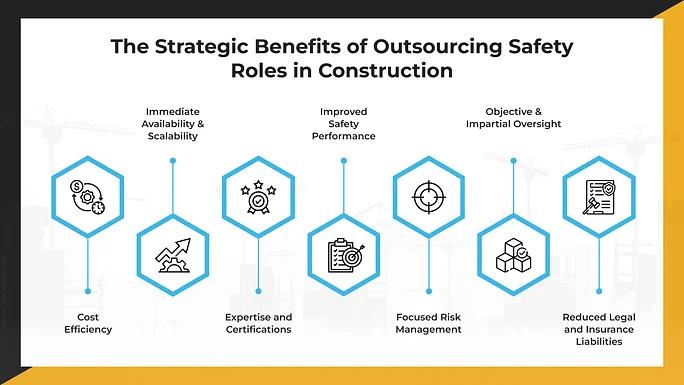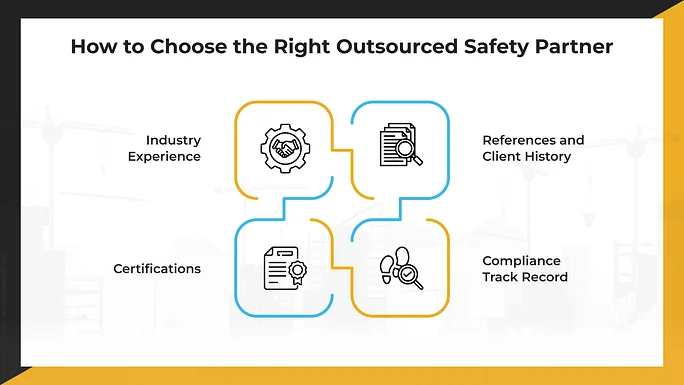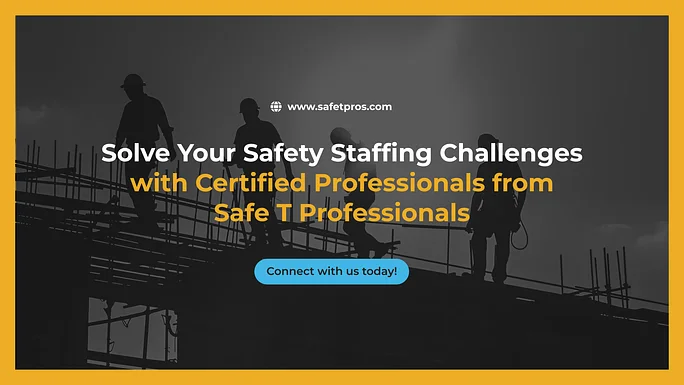How much does safety cost for your construction project? Not just in fines, delays, rework, and missed milestones?
Safety management takes up more time and energy for many construction teams than expected. With changing OSHA guidelines, constant inspections, insurance paperwork, and training requirements, staying compliant can stretch your internal team, especially when handling multiple projects simultaneously.
What’s often missed is that safety issues don’t always show up as clear violations. Sometimes, it’s idle equipment during an investigation, subcontractors waiting around during re-training, or project deadlines slipping because reports weren’t done right.
These minor setbacks can turn into considerable costs quickly.
More construction companies are turning to outsourced safety staffing to keep projects moving, stay compliant, and protect profits. This blog will explain exactly how outsourced safety staffing works, when it makes the most sense, and its specific advantages.
Understanding Outsourced Safety Staffing
Outsourced safety staffing involves hiring external safety professionals through a staffing agency or specialized safety consultancy to manage and oversee workplace safety on construction sites. These professionals are not direct employees of the construction firm but act as integral, on-site resources to ensure regulatory compliance, enforce safety protocols, and minimize risk.
This is particularly practical for companies that operate multiple job sites simultaneously, experience fluctuations in project volume, require specialized safety skills for high-risk phases of work, or cannot maintain a full-time internal safety department.
Common Roles Filled Through Outsourcing
Depending on the size and scope of the construction project, different safety roles may be outsourced. These include:
| Role | Primary Responsibilities |
| Site Safety Officer (SSO) | Enforces site safety rules, conducts inspections, and leads daily safety briefings. |
| Safety Manager | Develops site-specific safety plans, coordinates with project teams, and ensures compliance with OSHA standards. |
| Compliance Inspector | Conducts regulatory inspections and prepares documentation for audits. |
| Safety Auditor | Evaluates safety systems, identifies gaps, and recommends corrective actions. |
| Environmental Health & Safety (EHS) Specialist | Manages job site exposure risks related to hazardous materials, air quality, noise, etc. |
| Certified Safety Professional (CSP) | Offers high-level strategic safety planning and may serve in advisory roles for complex or high-risk projects. |
The Hidden Costs of Ignoring Safety on Job Sites
Construction accounts for a disproportionate share of workplace injuries and deaths in the U.S. and globally. Data from the Occupational Safety and Health Administration (OSHA) underscores the severity of the issue:
1 in 5 worker deaths in the U.S. occurs in the construction industry. In 2023, OSHA reported over 1,000 construction-related fatalities in the U.S. alone. The leading causes of death in construction—known as OSHA’s “Fatal Four” are falls (from heights, scaffolds, ladders),struck-by objects (tools, machinery, falling materials), electrocutions, and caught-in/between incidents (machinery, collapsing structures)
Construction safety is guided by federal, state, local, and even client-specific rules. At the federal level, OSHA sets and enforces workplace safety standards. Employers must keep job sites hazard-free, train workers, and report incidents. Breaking these rules can lead to fines (ranging from $1,000 to over $150,000) or even stop-work orders.
ANSI creates voluntary safety guidelines, like those for PPE and fall protection, that are often treated as best practices on job sites. In addition, state and local governments may have stricter safety laws, especially in large cities or specific industries. Contractors working in different states must know and follow all applicable rules.
The Strategic Benefits of Outsourcing Safety Roles in Construction
Outsourcing safety staff allows construction companies to manage workplace risks effectively while staying cost-efficient and operationally agile. Below are the primary benefits of adopting outsourced safety staffing:
1. Cost Efficiency
Hiring full-time, in-house safety personnel involves recurring expenses such as salaries, healthcare benefits, retirement contributions, training, and administrative overhead. According to industry benchmarks, the average annual cost of employing a full-time certified safety manager can exceed $90,000 to $120,000, excluding additional benefits and onboarding costs.
By outsourcing, companies can access qualified safety experts on a project-by-project basis or during peak construction periods. This model eliminates the need for long-term financial commitments while maintaining high safety standards. It also helps small and mid-sized contractors meet compliance requirements without the burden of staffing a whole safety department.
2. Immediate Availability & Scalability
Construction timelines can shift rapidly, especially when handling multi-site or fast-track projects. Outsourced safety providers can supply trained personnel on short notice, enabling companies to ramp up operations without delays. This immediate availability ensures that safety protocols are enforced from day one, even in high-risk project startups.
Additionally, staffing can be scaled based on the project phase. For instance, more personnel can be deployed during demolition or heavy equipment operation, then scaled back during finishing work. This flexibility prevents overstaffing and controls labor costs while maintaining compliance at every stage.
3. Expertise and Certifications
Outsourced safety professionals often hold certifications such as OSHA 30, HAZWOPER, CHST (Construction Health and Safety Technician), CSP (Certified Safety Professional), or MSHA credentials for mining-related construction. These qualifications are critical for compliance and are often required on federal or union-regulated job sites.
Moreover, external safety experts stay current with changing safety laws, emerging risks, and best practices across different jurisdictions. This ensures your project benefits from the latest regulatory knowledge without requiring internal upskilling or constant retraining.
4. Improved Safety Performance
Outsourced professionals enforce site-specific safety plans, conduct regular audits, and lead mandatory toolbox talks. These experts proactively identify hazards, address unsafe behaviors, and introduce preventive measures.
As a result, incident rates and near-misses decrease, leading to smoother project execution and higher workforce morale. Better safety records often make bidding for large public or private contracts easier.
5. Focused Risk Management
A dedicated outsourced safety team brings structure to risk management processes. They handle essential activities like site walkthroughs, hazard identification, PPE compliance checks, and emergency response planning. They also document every step, from daily inspections to incident investigations.
This level of detailed documentation supports internal reporting, ensures audit readiness, and provides crucial evidence in case of regulatory inspections or legal claims. It also helps project managers make informed decisions based on real-time safety data.
6. Objective & Impartial Oversight
Internal safety personnel may face challenges when addressing safety violations involving supervisors, crew members, or long-standing subcontractors. Outsourced safety staff bring an impartial perspective, enabling them to enforce policies without bias or internal pressures.
This external oversight promotes consistency and fairness, reducing the likelihood of overlooking violations or allowing unsafe practices due to familiarity. It also supports a transparent and accountable safety culture on-site.
7. Reduced Legal and Insurance Liabilities
Properly managed safety programs significantly reduce the risk of litigation and insurance claims. Detailed records, documented training sessions, and third-party validation can be crucial for legal defense when incidents occur.
According to the National Safety Council, the average cost of a medically consulted construction injury exceeds $44,000, not including legal fees or project delays. In addition, many insurers offer reduced premiums to contractors who can demonstrate strong safety performance, including the use of professional safety personnel. This can translate into substantial long-term savings on workers’ compensation and general liability policies.
When to Outsource Construction Safety Staff: Use Cases
Outsourced safety staffing is a practical solution in construction scenarios where internal resources are limited or specialized oversight is required. Below are the situations where outsourcing safety professionals adds clear operational value:
1. Short-Term Projects
Hiring full-time safety staff is often impractical for short-term construction projects, such as tenant improvements, small-scale infrastructure upgrades, or equipment installations.
Outsourcing allows firms to hire certified safety personnel for the project timeline. This ensures regulatory compliance and proper oversight without committing to long-term employment contracts.
2. Multi-site Operations
Maintaining consistent safety coverage across all locations becomes challenging when a contractor manages multiple job sites simultaneously. Outsourced safety professionals can be deployed to different sites based on risk levels, activity phases, or inspection schedules. This flexible deployment model ensures that each site receives adequate attention without overstretching internal resources.
3. Specialized Environments
Projects involving confined spaces, hazardous materials, or complex mechanical systems often require safety professionals with advanced certifications and training.
For example, asbestos removal, chemical handling, or trenching require specific OSHA or HAZWOPER compliance. Outsourced safety staff with relevant expertise can address these specialized risks more effectively than generalist safety personnel.
4. Rapid Project Mobilization
Some projects—especially those with urgent timelines or regulatory pressure- require immediate mobilization of labor and equipment. In such cases, bringing in a third-party safety team helps establish a compliant safety framework from day one.
This includes preparing job hazard analyses, conducting worker orientations, and ensuring that required safety documentation is in place before work begins.
5. High-Risk Phases of Work
Certain project phases carry higher risks and require increased safety supervision. These include demolition, excavation, steel erection, roofing, and working at heights.
During these critical activities, temporary safety staffing helps monitor compliance closely, conduct real-time hazard assessments, and ensure that controls such as fall protection and lockout/tagout systems are adequately enforced.
How to Choose the Right Outsourced Safety Partner
Selecting the right safety staffing provider is critical to ensuring job site compliance, minimizing risk, and maintaining operational efficiency.
Not all agencies or consultants offer the same level of service, so it’s essential to evaluate potential partners using specific criteria and ask the right questions before entering into any agreement. Here is what to look for in a staffing agency:
1. Industry Experience
Start by reviewing the agency’s experience in the construction sector. A firm specializing in construction safety will be more familiar with the day-to-day challenges of active job sites, relevant OSHA standards, and industry-specific risks.
Ask how many years they’ve been operating and what types of projects they support, commercial, residential, infrastructure, or industrial.
2. Certifications
Ensure that the agency provides safety professionals with valid and up-to-date certifications. Common credentials to look for include OSHA 30/OSHA 500, CHST (Construction Health and Safety Technician), CSP (Certified Safety Professional), HAZWOPER, and any state-specific training where the project is located. These certifications confirm that the personnel meet legal requirements and follow current best practices.
3. References and Client History
A reputable safety partner should be willing to share references or case studies from past clients. This helps validate their claims about quality and reliability.
Look for feedback on their responsiveness, site integration, reporting accuracy, and professionalism. A strong client history, especially with repeat engagements, is a good sign of consistent performance.
4. Compliance Track Record
Inquire about the firm’s compliance history. Have any of their staff or client sites faced OSHA violations while under their supervision?
A clean record or a proven ability to resolve issues quickly and correctly is a strong indicator of their competence and reliability. Some firms may also offer audit preparation or assistance, which adds value.
Questions to Ask Before Signing an Agreement:
|
Asking detailed questions before committing to a contract helps prevent misunderstandings and ensures alignment with your safety goals. Different projects require different safety protocols. Ask how the agency customizes onboarding and training to match your job site’s scope, hazards, and workflow. Confirm whether they conduct on-site orientations or rely on pre-written modules.
Clarify whether the safety professionals provided are direct agency employees or independent subcontractors. This affects legal liability, oversight, and quality control. Direct employees are more accountable and easier to manage under consistent standards.
Confirm that the agency holds adequate liability insurance, including general liability, workers’ compensation, and professional liability coverage. Request proof of insurance and understand how responsibility is shared during an incident. This protects your company from legal and financial exposure.
Why Choose Safe T Professionals for Your Safety Staffing Needs
Safe T Professionals is a trusted EHS staffing partner that combines speed, expertise, and nationwide reach. Here’s why contractors and project managers across industries rely on us:
- EHS-Only Focus – We specialize exclusively in Environmental, Health, and Safety staffing, ensuring deep industry knowledge.
- Certified Experts – Our professionals hold advanced certifications like OSHA 500, MS, ASP/CSP.
- Rapid Deployment – We typically staff your project within 72 hours—no delays, no downtime.
- Nationwide & International Network – Access top-tier EHS professionals across the U.S. and Asia.
- Cost & Time Efficiency – We handle the recruitment, screening, and onboarding, saving you time and reducing hiring costs.
- W2 Employees: We handle payroll, benefits, and taxes, simplifying compliance and budgeting for you.
- Reliable & Ready Talent Pool – Our database comprises vetted, trained safety personnel ready to step in when needed.
- Client-Centered Service – We focus on long-term relationships, delivering value through consistent support and results.
Solve Your Safety Staffing Challenges with Certified Professionals from Safe T Professionals
At Safe T Professionals, we are dedicated to elevating safety standards through our expert consulting and staffing services. By proactively addressing and preventing safety issues and equipping your workforce with the necessary knowledge and tools, we help create a safer work environment.
Partner with Safe T Professionals to enhance your company’s HSE protocols, ensure compliance with industry regulations, and mitigate workplace hazards. Whether you are looking to fill safety-specific roles or need expert consultation to reduce workplace hazards, we are here to help.
Connect with us today!




